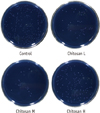1. Kato K, Fukui K, Nakagaki H, Sato T, Takahashi N. Density profiles of total bacteria and S. mutans within dental plaque treated with stannous fluoride gel. Int Congr Ser. 2005. 1284:185–186.

2. Imazato S. Antibacterial properties of resin composites and dentin bonding systems. Dent Mater. 2003. 19:449–457.

3. Addy M, Thaw M.
In vitro studies into the release of chlorhexidine acetate, prednisolone sodium phosphate, and prednisolone alcohol from cold cure denture base acrylic. J Biomed Mater Res. 1982. 16:145–157.

4. Wilson SJ, Wilson HJ. The release of chlorhexidine from modified dental acrylic resin. J Oral Rehabil. 1993. 20:311–319.

5. Jedrychowski JR, Caputo AA, Kerper S. Antibacterial and mechanical properties of restorative materials combined with chlorhexidines. J Oral Rehabil. 1983. 10:373–381.

6. Imazato S, Russell RR, McCabe JF. Antibacterial activity of MDPB polymer incorporated in dental resin. J Dent. 1995. 23:177–181.

7. Uragami T, Yamamoto S, Miyata T. Dehydration from alcohols by polyion complex cross-linked chitosan composite membranes during evapomeation. Biomacromolecules. 2003. 4:137–144.

8. Ikinci G, Senel S, Akincibay H, Kaş S, Erciş S, Wilson CG, Hincal AA. Effect of chitosan on a periodontal pathogen Porphyromonas gingivalis. Int J Pharm. 2002. 235:121–127.
9. Chung YC, Wang HL, Chen YM, Li SL. Effect of abiotic factors on the antibacterial activity of chitosan against waterborne pathogens. Bioresour Technol. 2003. 88:179–184.

10. Helander IM, Nurmiaho-Lassila EL, Ahvenainen R, Rhoades J, Roller S. Chitosan disrupts the barrier properties of the outer membranes of gram-negative bacteria. Int J Food Microbiol. 2001. 71:235–244.

11. Rabea EI, Badawy ME, Stevens CV, Smagghe G, Steurbaut W. Chitosan as antimicrobial agent: applications and mode of action. Biomacromolecules. 2003. 4:1457–1465.

12. Chung YC, Su YP, Chen CC, Jia G, Wang HL, Wu JC, Lin JG. Relationship between antibacterial activity of chitosan and surface characteristics of cell wall. Acta Pharmacol Sin. 2004. 25:932–936.
13. Decker EM, von Ohle C, Weiger R, Wiech I, Brecx M. A synergistic chlorhexidine/chitosan combination for improved antiplaque strategies. J Periodontal Res. 2005. 40:373–377.

14. Choi BK, Kim KY, Yoo YJ, Oh SJ, Choi JH, Kim CY.
In vitro antimicrobial activity of a chitooligosaccharide mixture against
Actinobacillus actinomycetemcomitans and
Streptococcus mutans. Int J Antimicrob Agents. 2001. 18:553–557.

15. Fujiwara M, Hayashi Y, Ohara N. Inhibitory effect of water-soluble chitosan on growth of Streptococcus mutans. New Microbiol. 2004. 27:83–86.
16. Tarsi R, Muzzarelli RA, Guzmán CA, Pruzzo C. Inhibition of
Streptococcus mutans adsorption to hydroxyapatite by low-molecular-weight chitosans. J Dent Res. 1997. 76:665–672.

17. Tarsi R, Corbin B, Pruzzo C, Muzzarelli RA. Effect of low-molecular-weight chitosans on the adhesive properties of oral streptococci. Oral Microbiol Immunol. 1998. 13:217–224.

18. Miyazaki S, Nakayama A, Oda M, Takada M, Attwood D. Chitosan and sodium alginate based bioadhesive tablets for intraoral drug delivery. Biol Pharm Bull. 1994. 17:745–747.

19. Hernández-Lauzardo AN, Bautista-Baños S, Velázquezdel Valle MG, Méndez-Montealvo MG, Sánchez-Rivera MM, Bello-Pérez LA. Antifungal effects of chitosan with different molecular weights on
in vitro development of Rhizopus stolonifer (Ehrenb.:Fr.) Vuill. Carbohydr Polym. 2008. 73:541–547.

20. Madihally SV, Matthew HW. Porous chitosan scaffolds for tissue engineering. Biomaterials. 1999. 20:1133–1142.

21. Bae K, Jun EJ, Lee SM, Paik DI, Kim JB. Effect of water-soluble reduced chitosan on
Streptococcus mutans, plaque regrowth and biofilm vitality. Clin Oral Investig. 2006. 10:102–107.

22. Kaş HS. Chitosan: properties, preparations and application to microparticulate systems. J Microencapsul. 1997. 14:689–711.

23. Sano H, Matsukubo T, Shibasaki K, Itoi H, Takaesu Y. Inhibition of adsorption of oral streptococci to saliva treated hydroxyapatite by chitin derivatives. Bull Tokyo Dent Coll. 1991. 32:9–17.
24. Tanzer JM. Slots J, Taubman M, editors. Microbiology of dental caries. Contemporary oral microbiology and immunology. 1992. St. Louis: Mosby;377–424.
25. Slots J, Gibbons RJ. Attachment of
Bacteroides melaninogenicus subsp. asaccharolyticus to oral surfaces and its possible role in colonization of the mouth and of periodontal pockets. Infect Immun. 1978. 19:254–264.

26. Wise MD, Dykema RW. The plaque-retaining capacity of four dental materials. J Prosthet Dent. 1975. 33:178–190.

27. Frank RM, Steuer P. Transmission electron microscopy of plaque accumulations in denture stomatitis. J Prosthet Dent. 1985. 53:115–124.

28. Skjörland KK. Plaque accumulation on different dental filling materials. Scand J Dent Res. 1973. 81:538–542.

29. Skjørland KK, Sønju T. Effect of sucrose rinses on bacterial colonization on amalgam and composite. Acta Odontol Scand. 1982. 40:193–196.

30. Sano H, Shibasaki K, Matsukubo T, Takaesu Y. Effect of chitosan rinsing on reduction of dental plaque formation. Bull Tokyo Dent Coll. 2003. 44:9–16.

31. Chen YM, Chung YC, Wang LW, Chen KT, Li SY. Antibacterial properties of chitosan in waterborne pathogen. J Environ Sci Health A Tox Hazard Subst Environ Eng. 2002. 37:1379–1390.

32. Busscher HJ, Engels E, Dijkstra RJ, van der Mei HC. Influence of a chitosan on oral bacterial adhesion and growth in vitro. Eur J Oral Sci. 2008. 116:493–495.









 PDF
PDF ePub
ePub Citation
Citation Print
Print




 XML Download
XML Download